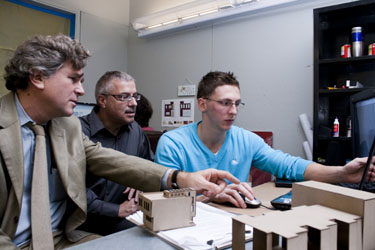Architecture schools, beyond the classroom

Tomorrow's architects share something with their colleagues educated in the 1960s and 70s: A strong interest in using design to help the disadvantaged and displaced.

The trend among leading architecture schools has been to marshall the brains and muscle of students for projects that really make a difference. This is embodied nowhere better, perhaps, than at the Newark-based New Jersey Institute of Technology (NJIT) School of Architecture, one of the country's top-five biggest programs.
The school calls it experiential learning, but I call it good works. Best of all, it involves "real-life projects with real deliverables for real clients," says Darius Sollohub, the school's director.
Lessons of resiliency
NJIT's new "resiliency studio," for example, reminds us that these architecture students were working in Seaside Heights, N.J., long before Hurricane Sandy hit -- even before Snooki and MTV's "Jersey Shore" crew hit the scene -- trying to put a ‘there’ there.
Led by planner Thomas G. Dallessio, the resilient design projects include prototypes for specific communities, a new clearinghouse for expertise and assistance, and a weeklong community service program of "resilient rebuilding."
NJIT already has plenty of experience. It has worked with Habitat for Humanity, the city of New Orleans, and its neighbors in East Orange, N.J., an impoverished community where architecture can indeed make a difference. The current design studio is showing how to use high-performance concrete for super-resilient, “next-gen” buildings along hurricane-prone shores in coastal New Jersey.
Workable solutions
Other schools around the country are digging into local issues, offering workable solutions and human energy.
These schools deserve much credit. But often it's an alliance with Habitat or Architecture for Humanity that makes the projects happen -- and makes them more valuable for the affected beneficiaries.
In some cases, it's the student alone that makes the commitment to help neighbors.
My favorite story this week involves Jason Minter, a Texas A&M architecture student who read the recent Salon.com critique that architects are disconnected from the middle class.
Minter did not like this idea at all. So he left the school's cloistered studio and went door-to-door in the neighborhood offering his architecture services -- for free -- for a worthy project.
Making architects relevant
"How can architects regain some type of importance in the general discourse?" Minter rhetorically asked The Eagle of Bryan, Texas. "My claim is that if we leave our studios and leave our classic clients and go out into the streets, go door-to-door and put ourselves out there in the general public ... we could rebrand our profession, letting the general public know that we don't just build buildings."
Minter found his client, a budding local bakery, and then looked for a low-cost design using recycled materials. His previous work with Habitat for Humanity helped keep the project real -- and real-world.
Bravo, Mr. Minter. We need more like you.
Thank goodness architecture programs around the country are stepping out into their communities and giving back. At the Montana State University School of Architecture, the students from Bozeman are lending expertise and resources to a needy Boys & Girls Club in the oil-field town of Sidney, where a "lack of space is dire."
At Keene State College, architecture students are designing a "self-sustaining" school for Haiti, working with Architecture for Humanity Boston on the vocational and technical facility. It's more than a design exercise, says Keene State associate professor Peter L. Temple -- it's about "empowering the local people with the skills they need so they can rebuild," he told a local paper.
There are certainly more examples of this attitude in other U.S. architecture schools, and I applaud them all. There are plenty of ambitious, real-life projects and alliances with groups like the Smithsonian, the Department of Energy and others.
But when architecture students are practitioners who look to their neighbors and communities -- just like A&M's Jason Minter chose to -- we quickly see the vast impact that design has to support, ameliorate and edify.
This post was originally published on Smartplanet.com